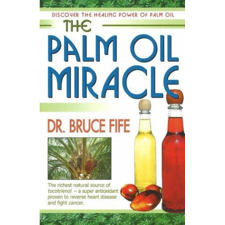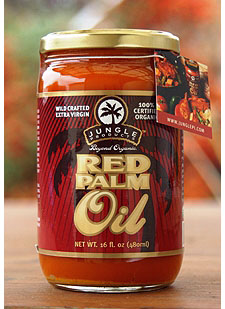Palm oil is finding a place in many homes and schools as a trans fat-free alternative to hydrogenated vegetable oils. Red palm oil does not contain artificial colors, preservatives, trans fatty acids, or cholesterol. It provides many nutrients, including vitamins A, E, K and CoQ10. As knowledge of the health aspects of palm oil become more widely known, it will hopefully replace health destroying hydrogenated fats and shortenings!
Richest Source of Carotenoids
Red palm oil has a higher bioavailability of antioxidant nutrients (proportion of nutrients that are usable by the body) than other vegetable source. It is considered the richest natural source of carotenoids with concentrations of 700-1000 ppm. That's 30 times more than what is contained in carrots!
Red palm oil contains high concentrations of beta- and alpha-carotene, which make up approximately 90% of its total carotenoid content. Importantly, red palm oil is one of the few excellent dietary sources of alpha-carotene, which has been shown to have even more powerful anticancer effects than beta-carotene.
The most widely studied and well understood nutritional role for carotenoids is their pro-vitamin A activity. Vitamin A can be produced within the body from certain carotenoids, notably beta-carotene. Scientists believe that because of its high carotenoid content red palm oil may boost the immune system.
Moreover, it is well recognized that the carotenoids are most stable and best absorbed in the presence of fat, which acts as the carrier. In addition to the beta-carotene, which accounts for 55% of the carotenoids in red palm oil, it contains several other carotenoids that have properties different from their pro-vitamin A activity. Alpha-carotene (35%), lycopene, phytoene, and zeta-carotenes are the other major constituent carotenoids in red palm oil. All of these carotenoids have shown impressive anti-cancer properties, and unlike synthetic beta-carotene supplements, red palm oil contains a natural mix of many carotenoids.
Contains Beneficial Fats
The fatty acid composition of palm oil is similar to that of the fat tissue in most people on an ordinary diet. It contains a healthy mixture of all the types of fatty acids: 10% polyunsaturated, 40% monounsaturated and 50% saturated fatty acids. The saturated fatty acids are made up of 44% palmitic acid and 5% stearic acid. The unsaturated fatty acids consist of 39% oleic acid (monounsaturates) and 10% linoleic acid (polyunsaturates).
Palmitic acid, a 16-carbon-chain saturated fat, makes up almost half of the fatty acids in red palm oil. That means it's good for supplying energy that is easy to digest and does not cause a rise in blood sugar or insulin. Red palm oil is a good source of easy-to-digest calories without putting a burden on insulin production. It won't cause syndrome X and it won't raise your triglycerides or LDLs.
Health Benefits of Palm Oil
Recent medical studies have shown that palm oil, particularly red palm oil, can protect against many common health problems.
According to Dr. Bruce Fife, in his book The Palm Oil Miracle, palm oil benefits include:
- Improves blood circulation
- Protects against heart disease
- Protects against cancer
- Improves blood sugar control
- Improves nutrient absorption (as well as vitamin and mineral status)
- Aids in the prevention and treatment of malnutrition
- Supports healthy lung and liver function
- Helps strengthen bones and teeth
- Supports eye health
- Highest natural source of health promoting tocotrienols
- Helps protect against mental deterioration, including Alzheimer’s disease
- Richest dietary source of Vitamin E and beta-carotene
- Boosts immunity

